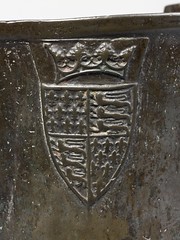By Stuart Frost
The detail you can see here is a heraldic device that adorns a vast bronze jug, destined for the new Medieval and Renaissance Galleries. The coat-of-arms is that of King Richard II. If you look closely you can see that the shield is quartered, and decorated with the fleur-di-lis of France and the lions of England. The coat-of-arms reflects the English claim to the French crown. Click on the image to find out more about the coat-of-arms and the object it adorns.
 The French, of course, no longer have a monarchy. President Sarkozy is making a state visit to Britain this week and it appears that a closer relationship between Britain and France is developing. In recent years there has occasionally been friction between the French and English governments but fortunately nothing to compare with the hostility that existed during the later Middle Ages when the French and English kingdoms were almost constantly fighting in a period now known as the Hundred Years War.
The French, of course, no longer have a monarchy. President Sarkozy is making a state visit to Britain this week and it appears that a closer relationship between Britain and France is developing. In recent years there has occasionally been friction between the French and English governments but fortunately nothing to compare with the hostility that existed during the later Middle Ages when the French and English kingdoms were almost constantly fighting in a period now known as the Hundred Years War.
Today we have the media to keep us informed about diplomatic relations, and a great deal of less essential information about the private lives of the great, the good and the d-list celebrity. For the Hundred Years War the greatest chronicler was Jean Froissart, perhaps the closest parallel for a modern journalist in the fourteenth century. I have to admit that the journalist parallel isn’t a very good one.
Froissart was born in 1337 into a Europe very different to our own. His home town was Valenciennes, Hainault (now on the French-Belgian border) but he travelled widely. Around 1361-62 he crossed the Channel to England to join the court of Philippa of Hainault, King Edward III of England’s queen. Here he wrote a rhymed history of the recent wars between England and France, but continued to rewrite and expand his work throughout his life, turning from poetry to prose. His Chronicles cover the period between 1325 and 1400 including evocative accounts of the great English victories at the battles of Crécy (1346) and Poitiers (1356).
The reason I mention this is that I’ve been reading his Chronicles in search of quotes that we might be able to use on subject panels to help try and give a personalised view of the period covered by the Medieval and Renaissance displays. I also visited an exhibition, The Chronicles of Froissart, at the Royal Armouries in Leeds at the weekend.
The temporary display at the Armouries is based around a single illuminated manuscript of Froissart’s text known as the Stonyhurst Chronicles. This manuscript was brought back to England after the Agincourt campaign by Sir John Arundell in 1415. In 1837 James Arundell gave the manuscript to Stonyhurst College, and the College have loaned the manuscript to the Royal Armouries for the exhibition. I’m always interested to see how other museums go about developing displays around manuscripts as books aren’t the easiest things to display and we’re integrating a significant number throughout the new galleries.
The Chronicles of Froissart exhibition runs until 6 April 2008 so you haven’t got much time if you want to see it. However you can find out more via the exhibition microsite on the Royal Armouries website. For the most vivid insights into the events of the fourteenth century, and the life of a man who lived through remarkable times, I’d recommend reading the Chronicles themselves. Froissart’s book is in print, is easy to track down and it is also great read for anyone with an interest in history.
Click here to find out more about The Chronicles of Froissart exhibition.